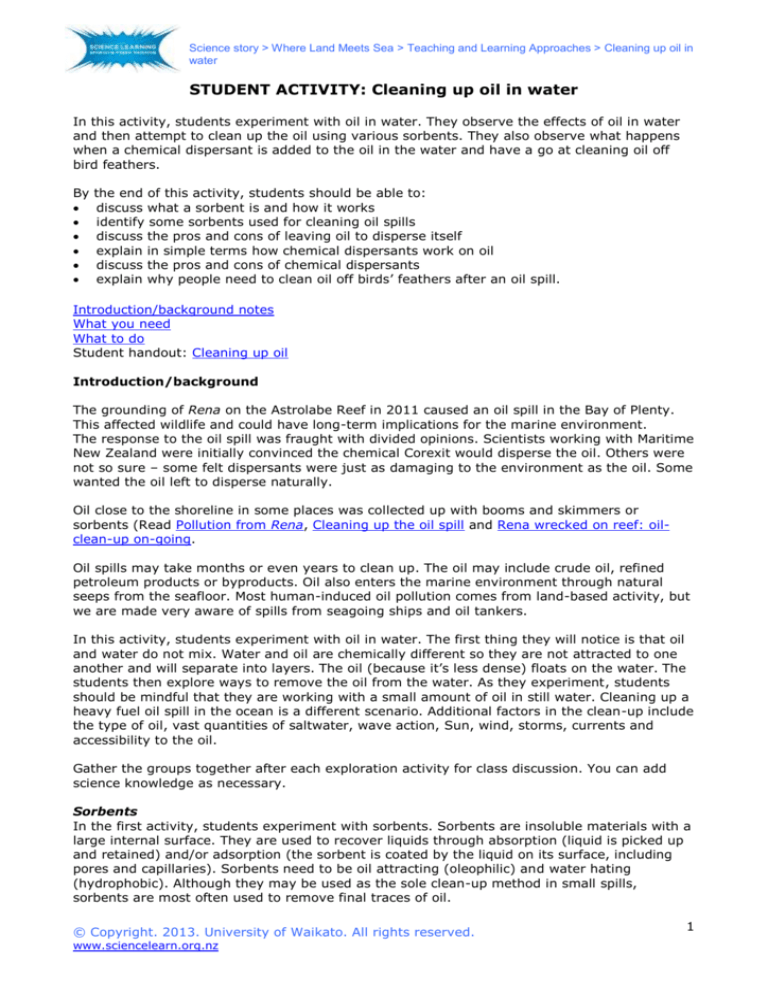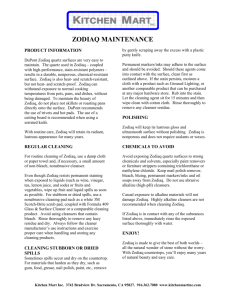
Science story > Where Land Meets Sea > Teaching and Learning Approaches > Cleaning up oil in
water
STUDENT ACTIVITY: Cleaning up oil in water
In this activity, students experiment with oil in water. They observe the effects of oil in water
and then attempt to clean up the oil using various sorbents. They also observe what happens
when a chemical dispersant is added to the oil in the water and have a go at cleaning oil off
bird feathers.
By
the end of this activity, students should be able to:
discuss what a sorbent is and how it works
identify some sorbents used for cleaning oil spills
discuss the pros and cons of leaving oil to disperse itself
explain in simple terms how chemical dispersants work on oil
discuss the pros and cons of chemical dispersants
explain why people need to clean oil off birds’ feathers after an oil spill.
Introduction/background notes
What you need
What to do
Student handout: Cleaning up oil
Introduction/background
The grounding of Rena on the Astrolabe Reef in 2011 caused an oil spill in the Bay of Plenty.
This affected wildlife and could have long-term implications for the marine environment.
The response to the oil spill was fraught with divided opinions. Scientists working with Maritime
New Zealand were initially convinced the chemical Corexit would disperse the oil. Others were
not so sure – some felt dispersants were just as damaging to the environment as the oil. Some
wanted the oil left to disperse naturally.
Oil close to the shoreline in some places was collected up with booms and skimmers or
sorbents (Read Pollution from Rena, Cleaning up the oil spill and Rena wrecked on reef: oilclean-up on-going.
Oil spills may take months or even years to clean up. The oil may include crude oil, refined
petroleum products or byproducts. Oil also enters the marine environment through natural
seeps from the seafloor. Most human-induced oil pollution comes from land-based activity, but
we are made very aware of spills from seagoing ships and oil tankers.
In this activity, students experiment with oil in water. The first thing they will notice is that oil
and water do not mix. Water and oil are chemically different so they are not attracted to one
another and will separate into layers. The oil (because it’s less dense) floats on the water. The
students then explore ways to remove the oil from the water. As they experiment, students
should be mindful that they are working with a small amount of oil in still water. Cleaning up a
heavy fuel oil spill in the ocean is a different scenario. Additional factors in the clean-up include
the type of oil, vast quantities of saltwater, wave action, Sun, wind, storms, currents and
accessibility to the oil.
Gather the groups together after each exploration activity for class discussion. You can add
science knowledge as necessary.
Sorbents
In the first activity, students experiment with sorbents. Sorbents are insoluble materials with a
large internal surface. They are used to recover liquids through absorption (liquid is picked up
and retained) and/or adsorption (the sorbent is coated by the liquid on its surface, including
pores and capillaries). Sorbents need to be oil attracting (oleophilic) and water hating
(hydrophobic). Although they may be used as the sole clean-up method in small spills,
sorbents are most often used to remove final traces of oil.
© Copyright. 2013. University of Waikato. All rights reserved.
www.sciencelearn.org.nz
1
Science story > Where Land Meets Sea > Teaching and Learning Approaches > Cleaning up oil in
water
A common oil-absorbing sorbent is made of synthetic fibres, principally polypropylene.
Polypropylene is a synthetic type of oil-based material. Polypropylene and oil are both
composed of carbon and hydrogen so their molecules are attracted to one another but do not
bond well to water. Polypropylene is used to gather oil spilled on water because it floats and
absorbs oil. Polypropylene is often used for winter clothing (undergarments, gloves and sock
liners). Students may have old polypropylene clothing that could be used for the experiment.
Polystyrene is an example of an adsorption material. It is also made of carbon and hydrogen
and attracts oil. (You’ll notice oil adheres to the surface of the polystyrene.)
Natural sorbents used for cleaning up oil in water include plants that have a high cellulose
content, hydrophobic and oleophilic abilities, good absorption capabilities, buoyancy even when
saturated with oil, resistance to wave action and the ability to be wrung out and reused to
soak up more oil. Examples are grass hay, wheat straw, untreated cotton and cotton stalks.
Sheep’s wool is also used to clean up oil spills from water. Wool has a natural ability to repel
water by aggressively attracting and holding grease and oil. It can absorb 10 to 30 times its
weight in oil while repelling water, making it significantly more oil absorbent than
polypropylene. Oil-sorbent wool products are light and easy to transport, biodegradable, highly
efficient at absorbing oil spills and can be wrung out and reused.
The problem with materials the students will trial such as cotton balls or pads is that they
absorb water as well as oil – limiting the amount of oil they can absorb and increasing the
number of cotton pads needed for the clean-up.
For more detailed, scientific explorations to determine effective sorbents, try experiments at
www.sciencebuddies.org/science-fair-projects/project_ideas/EnvEng_p025.shtml.
Natural dispersion
Sometimes, scientists will leave oil spills to disperse on their own. The Sun, wave action and
weather all contribute to the breakdown of oil in water. Eventually, the oil will evaporate.
However, this takes time, and scientists need to be sure that the slick doesn’t threaten wildlife,
business or civilisation in the meantime.
Chemical dispersants
Oil spills are often treated with chemical dispersants – they break down the oil more quickly
than if left alone. They break the oil slick apart, allowing oil droplets to mix with water and be
absorbed into the aquatic system more quickly. These chemicals pose their own danger,
however. The broken-down oil can be absorbed by marine life and into the food web. Also, the
chemical dispersant can itself be toxic to marine life if used in large quantities. In this
experiment, students see how detergent can disperse oil.
De-oiling feathers
A number of seabirds and animals died or were affected by the Rena oil spill. Oil makes birds’
feathers heavy and sticks them together, reducing their insulating ability and making them
less buoyant in the water. Oil makes it difficult for birds to swim or fly – reducing their ability
to obtain food or escape predators. As birds preen, they may ingest oil covering their feathers,
causing internal damage. Most birds affected by an oil spill die unless there is human
intervention. Read Rena bird recovery.
In this experiment, students explore the effects of oil on feathers. Students look at the natural
waterproofing of feathers and then at the effects of oil on a feather. They can then clean the
feather in the same way volunteers cleaned oil off feathers following the Rena oil spill. The
difference here, though, is that, while students can clean off the oil, they can’t waterproof it
again naturally. Live birds can preen and spread natural waterproofing oils through their
cleaned feathers.
© Copyright. 2013. University of Waikato. All rights reserved.
www.sciencelearn.org.nz
2
Science story > Where Land Meets Sea > Teaching and Learning Approaches > Cleaning up oil in
water
What you need (per group)
Copies of the student handout Cleaning up oil
Large clear bowl or container
Water
Aluminium foil
Spoon for stirring
Yellow vegetable oil
Sorbents cut up into manageable pieces – paper
towel, cotton balls or pads, towel rag,
polypropylene (old clothing or oil sorbent pads),
polyester cloth, kitchen sponge, polystyrene cup,
string, cheesecloth or gauze, sheep’s wool or
woollen cloth
Dishwashing detergent
Bird feathers
Spray bottle
Old toothbrush
Access to the articles Pollution from Rena, Cleaning up the oil spill and Rena bird recovery
and the news item Rena wrecked on reef: oil-clean-up on-going
Access to the YouTube clips www.youtube.com/watch?v=rT9HZkzEvRo and
www.youtube.com/watch?v=5mW6h0X7uK8
What to do
1. Divide the class into groups of about 3–4 and explain that each group will be exploring
cleaning up oil from water. They should discuss what they think is happening as they go.
Hand out copies of the student handout Cleaning up oil and discuss. What is a sorbent?
2. Assist groups of students to gather the equipment they need to conduct the experiments.
3. Have students complete steps 1–5 and discuss – why do you think one sorbent might be
better than others?
4. Watch this experiment on YouTube using a super-absorbent gel (hydrogel) – a superabsorbent polymer used in baby nappies www.youtube.com/watch?v=rT9HZkzEvRo. (You
could try the experiment found at
http://weirdsciencekids.com/OilspillexperimentPolymer.html.)
5. Discuss as a class why polymer products (such as hydrogel, polypropylene, polyester) are
effective in cleaning up oil spills. Why is sheep’s wool an effective oil sorbent?
6. Have students complete steps 6–8 and discuss.
7. As a class, read Cleaning up the oil spill and Rena wrecked on reef: oil-clean-up on-going.
8. Discuss as a class the pros and cons of leaving oil to disperse naturally and also the use of
chemical dispersants.
9. Explain that many seabirds are affected in an oil spill. The oil damages their feathers so
that they can’t function normally. Have students complete steps 9–12 and discuss.
10. As a class, read Rena bird recovery and watch the YouTube clip
www.youtube.com/watch?v=5mW6h0X7uK8 and discuss.
© Copyright. 2013. University of Waikato. All rights reserved.
www.sciencelearn.org.nz
3
Science story > Where Land Meets Sea > Teaching and Learning Approaches > Cleaning up oil in
water
Student handout: Cleaning up oil
Experimenting with sorbents
1. Pour water into a clear bowl or container until it’s
about half full.
2. Simulate an oil spill. Make a small canoe shape
with a piece of tinfoil. Fill it with oil and float it on
the water. Cause the boat to tip over creating an
oil spill.
3. Stir up the water and oil. Watch to see what
happens. Discuss what you think is happening
between the oil and water.
4. Predict which sorbent will clean up the oil the
best.
5. Try all the sorbents to see which one does the
best job. (You might need to add some more oil to
the water depending on the number of sorbents
you are trialling).
Natural and chemical dispersion
6. Tip out the water and clean the container. Set up the simulation again and cause an oil
spill.
7. Try to disperse the oil by ‘wave action’ (agitating the dish around). From your efforts, how
long do you think it would take to disperse naturally in the ocean setting? Discuss with your
group.
8. Add a few drops of dishwashing detergent to the oil spill. Mix it up. What happens? Why?
De-oiling feathers
9. Fill a spray bottle with water and spray a feather.
Note how the feather repels the water.
10. Immerse the feather in some vegetable oil. What
happens to the feather?
11. Spray water onto the feather. What happens?
12. Bathe the feather in soapy (detergent added)
water, cleaning it carefully with a toothbrush.
What happens?
© Copyright. 2013. University of Waikato. All rights reserved.
www.sciencelearn.org.nz
4










